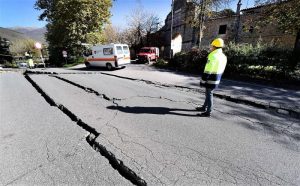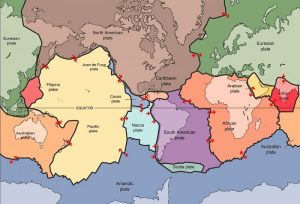Hypocenter
The hypocenter of an earthquake is the place where the rupture of the tectonic fault begins and is generally found at a certain depth below the surface of the ground, in the inner part of Earth. When an earthquake occurs, the hypocenter radiates a series of seismic waves that are directed in all directions. Expanding seismic waves travel at the rate of several kilometers per second and allow scientists to determine the location of the hypocenter.
What's a hypocenter?
The hypocenter is the correct term to use to refer to a point below the ground where an earthquake occurs. It is also known as a seismic focus.
The variations in velocity generated by the materials that the seismic waves encounter before arriving at each monitoring station are taken into account to give an initial estimate of the location of the hypocenter.
It is also known as seismic focus and is located in the inner part of the earth’s crust in the same place where the earthquakes originate and is located below the epicenter.
The hypocenter of an earthquake is considered to be the position where the tension energy stored in the rock is first released, marking the point where the fault begins to break. This occurs directly below the epicenter, at a distance known as focal or hypocentral depth.
Etymology
The word etymology is derived from the Greek words “ὑπο” which has as meaning below, and the word κέντρον pronounced as kentron, and which has as meaning center. As it is also indicated by Greek prefixes, it is a point located inside the lithosphere. Then, in other words, it is the exact or precise point (kentron) that is located below (hypo) the epicenter of the earthquake.
The term was coined in 1859 by the geophysicist of Irish origin Robert Mallet, and he used it to determine the point in the depths of the earth where it originates the force responsible for producing an earthquake.
How the hypocenter differs from the epicenter
The hypocenter of an earthquake is the actual location by estimating the rupture, and the depth of the rupture along the fault or subduction zone. The epicenter of an earthquake is the point on the surface directly above the hypocenter, this allows us the correct location on a map of the surface and serves to show the affected areas. In other words, the hypocenter is the point within the surface where the earthquake occurs, is measured in kilometers deep and the epicenter is the place where that hypocenter is located. In some occasions, the epicenter of the earthquake is the place where more damages are produced, although this is not a general rule, because depending on the intensity of the movement, the damages can extend in different places to the epicenter.
Examples of hypocenter
- Earthquake in Japan: This earthquake occurred in March 2011 and had a hypocenter 24 kilometers It was caused by an inverse failure of the Pacific and North American interplates. It had a magnitude of 9 degrees that gave rise to a tsunami with waves up to 10 meters high. It lasted approximately 6 minutes and was preceded by another tremor two days earlier with an intensity of 7.2 and a hypocenter of 14.1 kilometers. The experts of the NASA consider that the earthquake managed to move the Japanese island 2.4 meters and altered the axis of the earth by 10 centimeters.
- Coquimbo Earthquake: It happened on Wednesday, September 16, 2015 and reached a magnitude of 4 on the Richter scale. Its hypocenter was 37 kilometers deep and was located southwest of Canela Baja in Coquimbo. It could even be felt in Argentina, Uruguay and Brazil. It originated from the Nazca plate when it was introduced under the South American plate. This earthquake had replicas for 30 days with magnitudes higher than 3 degrees.
- Mexico Earthquake: In 1985, on Thursday, September 19, 1985, an enormous earthquake with a magnitude of 8.1 degrees occurred. Its hypocenter was only 15 kilometers deep in the earth’s crust. One of the most affected cities was Mexico City and is considered the most damaging in history. The official number of deaths was never known and affected the country economically, 250,000 people lost their homes and more than 900,000 were forced to leave their homes by unstable structures.
How to cite this article?
Briceño V., Gabriela. (2019). Hypocenter. Recovered on 23 February, 2024, de Euston96: https://www.euston96.com/en/hypocenter/










